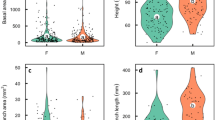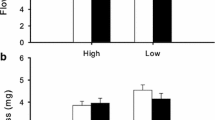Abstract
The reproductive biology of the sympatric species Gagea lutea and Gagea spathacea was analyzed morphologically and by resource allocation measurements. Both taxa reproduce vegetatively by bulbils. The hexaploid G. lutea regularly forms seeds, but flowering plants cease to produce bulbils. Seed set was never observed in nonaploid G. spathacea which does not stop vegetative reproduction when flowering. In this species, the pollen contains a high proportion of non-viable grains. Already sterile plants invest more resources (per cent of total nitrogen) into bulbils than G. lutea (10.9 vs. 5.9%). For flowering plants, the respective values are 6.1% (flowers) plus 18.4% (bulbils) for G. spathacea versus 14.8% (flowers only) for G. lutea. G. spathacea lost the ability to reproduce sexually and relies solely on vegetative reproduction. This seems to require the breakdown of the switch mechanism between the bulbil and flower formation (as in G. lutea) and a higher net investment in reproduction, hampering individual growth.






Similar content being viewed by others
References
Archetti M (2004) Recombination and loss of complementation: a more than two-fold cost for parthenogenesis. J Evol Biol 17:1084–1097
Ashman TL (1994) Reproductive allocation in hermaphrodite and female plants of Sidalcea oregana ssp. spicata (Malvaceae) using four currencies. Am J Bot 81:433–438
Caparelli K, Peruzzi L, Cesca G (2006) A comparative analysis of embryo-sac development in three closely-related Gagea species (Liliaceae), with some considerations on their reproductive strategies. Plant Biosyst 140:115–122
Ceplitis A (2001) Genetic and environmental factors affecting reproductive variation in Allium vineale. J Evol Biol 14:721–730
Ceplitis A, Bengtsson BO (2004) Genetic variation, disequilibrium and natural selection on reproductive traits in Allium vineale. J Evol Biol 17:302–311
Gargano D, Peruzzi L, Caparelli K, Cesca G (2007) Preliminary observations on the reproductive strategies in five early-flowering species of Gagea Salisb. (Liliaceae). Bocconea 21:349–358
Geber MA, de Kroon H, Watson MA (1997) Organ preformation in mayapple as a mechanism for historical effects on demography. J Ecol 85:211–223
Gustafsson A (1946) Apomixis in higher plants. Part I. The mechanisms of apomixis. Lunds Univ Arsskr Adv 2(42):1–67
Haeupler H (1969) Bestimmungsschlüssel der Gagea-Arten im südlichen Niedersachsen im blütenlosen Zustand. Mitt. Florist-soziol Arbeitsgem 14:36–46
Henker H (2005) Goldsterne und Stinsenpflanzen in Mecklenburg-Vorpommern. Botanischer Rundbrief 39:14–37
Hultén E, Fries M (1986) Atlas of North European vascular plants: north of the Tropic of Cancer I–III. Koeltz Scientific Books, Königstein. http://linnaeus.nrm.se/flora. Accessed 20 Dec 2007
Irmisch Th (1850) Zur Morphologie der monokotylischen Knollen- und Zwiebelgewächse. Berlin
Jäger E (1973) Zur Verbreitung und Lebensgeschichte der Wildtulpe (Tulipa sylvestris L.) und Bemerkungen zur Chorologie der Gattung Tulipa L. Hercynia NF 10:429–448
Kearns CA, Inouye DW (1993) Techniques for pollination biologists. University Press of Colorado, Boulder
Kondo T, Miura T, Okubo N, Shimada M, Baskin C, Baskin J (2004) Ecophysiology of deep simple epicotyl morphophysiological dormancy in seeds of Gagea lutea (Liliaceae). Seed Sci Res 14:371–378
Korneck D, Schnittler M, Vollmer I (1996) Rote Listen und Florenlisten gefährdeter Pflanzen in Deutschland: Florenliste und Rote Liste der Farn- und Blütenpflanzen (Pteridophyta et Spermatophyta). Schriftenreihe Vegetationsk. 28:21–187
Levichev IG (1999a) Phytogeographical analysis of the genus Gagea Salisb. (Liliaceae). Komarovia 1:45–47
Levichev IG (1999b) The morphology of Gagea Saliasb. (Liliaceae) I. Subterranean organs. Flora 194:379–392
Levichev IG (2008) Historia Gagearum. http://www.binran.ru/infsys/gagea/index-eng.html. Accessed 10 Nov 2008)
Měsíček J, Hrouda L (1977) Chromosome numbers in Czechoslovak species of Gagea (Liliaceae). Folia Geobot Phytotax 9:359–368
Meusel HE, Jäger EJ, Weinert E (1965) Vergleichende Chorologie der zentraleuropäischen Flora, vol 1. Fischer, Jena
Nishikawa Y (1998) The function of multiple flowers of a spring ephemeral, Gagea lutea (Liliaceae), with reference to blooming order. Canad J Bot 76:1404–1411
Patterson TB, Givnish TJ (2002) Phylogeny, concerted convergence, and phylogenetic niche conservatism in the core Liliales: insights from rbcL and ndhF sequence data. Evolution 56:233–252
Peterson A, Peterson J (1999) Genotypic differentiation on an individual level in Gagea villosa (M. Bieb.) Duby, Gagea lutea (L.) Ker-Gawler and Gagea bohemica subsp. saxatilis (Koch) Pascher in Saxony-Anhalt using RAPD markers. J Appl Bot 73:228–233
Peterson A, Hohn H, Koch E, Peterson J (2004) A molecular phylogeny of the genus Gagea (Liliaceae) in Germany inferred from non-coding chloroplast and nuclear DNA sequences. Plant Syst Evol 245:145–162
Peterson A, Harpke D, Peruzzi L, Tison J-M, John H, Peterson J (2008a) Hybridization drives speciation in Gagea (Liliaceae). Plant Syst. Evol. doi: 10.1007/s00606-008-0102-3 (in press)
Peterson A, Levichev IG, Peterson J (2008b) Systematics of Gagea and Lloydia (Liliaceae) and infrageneric classification of Gagea based on molecular and morphological data. Mol Phylogen Evol 46:446–465
Peruzzi L (2003) Contribution to the cytotaxonomical knowledge of Gagea Salisb. (Liliaceae) sect. Foliatae A. Terracc. and synthesis of karyological data. Caryologia 56:115–128
Peruzzi L (2008a) Contribution to the cytotaxonomical knowledge of the genus Gagea Salisb. (Liliaceae). III. New karyological data from the central Mediterranean area. Caryologia 61:92–106
Peruzzi L (2008b) Hybridity as a main evolutionary force in the genus Gagea Salisb. (Liliaceae). Plant Biosyst 142:179–184
Peruzzi L, Aquaro G (2005) Contribution to the cytotaxonomical knowledge of Gagea Salisb. (Liliaceae). II. Further karyological studies on Italian populations. Candollea 60:237–253
Peruzzi L, Tison JM (2004) Verso una revisione biosistematica del genere Gagea Salisb. (Liliaceae) in Italia. Un nuovo tipo di approccio. Inform Bot Ital 36:470–475
Peruzzi L, Peterson A, Tison J-M, Peterson J (2008) Phylogenetic relationships of Gagea Salisb. (Liliaceae) in Italy, inferred from molecular and morphological data matrixes. Plant Syst Evol. doi: 10.1007/s00606-008-0081-4 (in press)
Richards AJ (2003) Apomixis in flowering plants: an overview. Philos Trans Ser B 358:1085–1093
van Raamsdonk LWD (1985) Pollen fertility and seed formation in the Ornithogalum umbellatum/angustifolium complex (Liliaceae/Scilloideae). Plant Syst Evol 149:287–297
Rothmaler W (founder), Jäger E, Werner K (eds) (2005). Exkursionsflora von Deutschland, vol 4. Gefäßpflanzen: Kritischer Band, 10th edn. Spektrum Akademischer Verlag, Munich
Schnittler M, Günther K-F (1999) Central European vascular plants requiring priority conservation measures—an analysis from national Red Lists and distribution maps. Biodivers and Conserv 8:891–925
Silvertown J (2008) The evolutionary maintenance of sexual reproduction: evidence from the ecological distribution of asexual reproduction in clonal plants. Int J Plant Sci 169:157–168
Tomović G, Niketić M (2005) Gagea spathacea (Hayne) Salisb. (Liliaceae)—a new species for the flora of Serbia. Ann Biol Sci Belgrad 57(4):291–294
Uphof JCT (1958–1960) A review of the genus Gagea Salisb. Plant Life 14: 124–132; 15: 151–161; 19: 163–176
Westergård M (1936) A cytological study of Gagea spathacea with a note on the chromosome number and embryo-sac formation in Gagea minima. CR Trav Carlsberg Lab Sér Physiol 21:437–451
Zarrei M, Zarre S (2005) Pollen morphology of the genus Gagea (Liliaceae) in Iran. Flora 200:96–108
Acknowledgments
Most of the measurements for morphological data were carried out within several student courses, and we wish to thank all participants, especially C. Brummond, J. Dobbert, N. Formella, H. Kasten, A. Krüger, M. Liermann, L. Lohmann, J. Mohr, L. Niehusen, A. Roschanski, S. Schmidt, and A.-K. Zießnitz. For permission and advice to use the N/C analyzer we are indebted to U. Möbius and S. Zerbe; for use of a fluorescence microscope to S. Stremlau and Ch. Stöhr. Search for localities, but also the organization of field work was supported by S. Starke and A. Klahr (all Institute of Botany and Landscape Ecology). For advices, especially concerning localities, we are grateful to H. Henker (Wismar). We wish to thank the “Staatliches Amt für Umwelt und Natur Ueckermünde” for permission to collect plants and two anonymous reviewers for useful comments and advices.
Author information
Authors and Affiliations
Corresponding author
Rights and permissions
About this article
Cite this article
Schnittler, M., Pfeiffer, T., Harter, D. et al. Bulbils contra seeds: reproductive investment in two species of Gagea (Liliaceae). Plant Syst Evol 279, 29–40 (2009). https://doi.org/10.1007/s00606-008-0143-7
Received:
Accepted:
Published:
Issue Date:
DOI: https://doi.org/10.1007/s00606-008-0143-7




